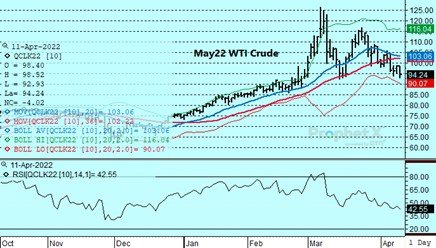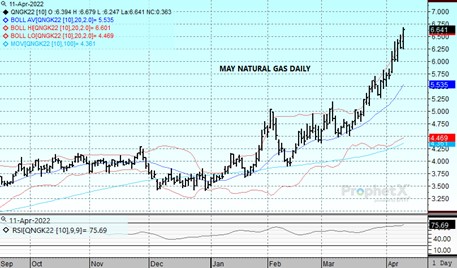by Stephen Platt and Mike McElroy
Price Overview
The petroleum complex traded on the defensive despite increased likelihood that the bulk of the EU will ban additional imports of Russian oil as international sanctions are ramped up for their invasion of Ukraine. The pressure, which saw WTI decline by as much as 5 dollars to a low of 92.93 basis May, reflected a combination of concerns linked to SPR releases, Chinese lockdowns, expected expansion of crude output in areas outside OPEC+, and continued entreaties by the EU to urge OPEC to expand production.
The scope of the SPR releases by the US and IEA and its impact on valuations has been apparent. The announced release by the US of 180 million barrels, or 1 mb/d over the next 6 months, along with an additional 60 mb to be released by IEA members, helps alter the supply situation going forward. The impact is even more pronounced due to uncertainty over demand due to slowing growth in Europe and China due to high energy prices and COVID-19 lockdowns.
It continues to be suggested that the withdrawal of supply from the US Strategic Petroleum Reserve puts the US in a more vulnerable position due to the draining of supplies. We would disagree given that the US is a nominal net exporter of energy, which puts us in substantially better shape to take this action than in the 2000-2010 period when net imports of crude and products was over 10 mb/d. This puts the US in a much stronger position economically than when we imported oil, although we remain subject to world valuations linked to global supply and demand.
We see May WTI trading as low as 92.00 and potentially as high as 115.00 as the world adjusts to the uncertain supply environment and the supply/demand adjustments in response to the higher prices and margins for petroleum-based products.

Natural Gas
Once again the pullback was short-lived as the May contract gained 36 1/2 cents today to settle at 6.643. The undercurrent of support continues to be provided by the war in Ukraine and the fallout from Europe’s plans to wean itself off Russian energy as increased sanctions become more likely each day. Weather has added to the upside bias, as US forecasts point to below normal temperatures on average for the second half of April. The slow growth in production continues to be a price driver as well, as it becomes more difficult to adequately rebuild supplies by the fall if marked improvement isn’t seen soon. Output did reach 95 bcf/d over the weekend, and with rig counts showing improvement it would appear that production increases are in the pipeline if crews can be found. The market remains overbought as RSI went back above 80 percent today, and we continue to expect a near term retracement that should find solid support near 6 dollars. A return to the upside finds the charts void of any resistance until the psychological 7-dollar level.

Futures and options trading involve significant risk of loss and may not be suitable for everyone. Therefore, carefully consider whether such trading is suitable for you in light of your financial condition. The information and comments contained herein is provided by ADMIS and in no way should be construed to be information provided by ADM. The author of this report did not have a financial interest in any of the contracts discussed in this report at the time the report was prepared. The information provided is designed to assist in your analysis and evaluation of the futures and options markets. However, any decisions you may make to buy, sell or hold a futures or options position on such research are entirely your own and not in any way deemed to be endorsed by or attributed to ADMIS. Copyright ADM Investor Services, Inc.
